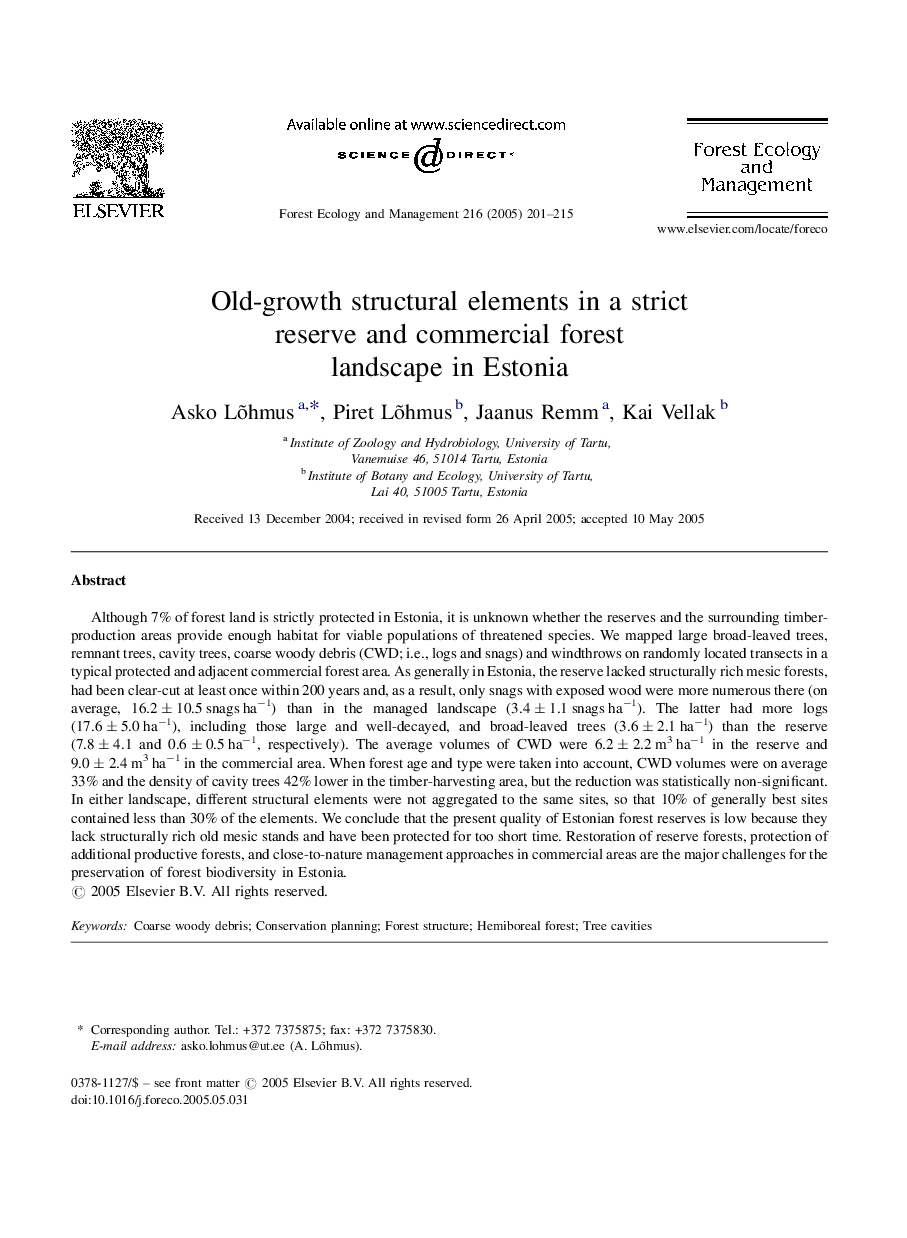| کد مقاله | کد نشریه | سال انتشار | مقاله انگلیسی | نسخه تمام متن |
|---|---|---|---|---|
| 9620179 | 159447 | 2005 | 15 صفحه PDF | دانلود رایگان |
عنوان انگلیسی مقاله ISI
Old-growth structural elements in a strict reserve and commercial forest landscape in Estonia
دانلود مقاله + سفارش ترجمه
دانلود مقاله ISI انگلیسی
رایگان برای ایرانیان
کلمات کلیدی
موضوعات مرتبط
علوم زیستی و بیوفناوری
علوم کشاورزی و بیولوژیک
بوم شناسی، تکامل، رفتار و سامانه شناسی
پیش نمایش صفحه اول مقاله

چکیده انگلیسی
Although 7% of forest land is strictly protected in Estonia, it is unknown whether the reserves and the surrounding timber-production areas provide enough habitat for viable populations of threatened species. We mapped large broad-leaved trees, remnant trees, cavity trees, coarse woody debris (CWD; i.e., logs and snags) and windthrows on randomly located transects in a typical protected and adjacent commercial forest area. As generally in Estonia, the reserve lacked structurally rich mesic forests, had been clear-cut at least once within 200 years and, as a result, only snags with exposed wood were more numerous there (on average, 16.2 ± 10.5 snags haâ1) than in the managed landscape (3.4 ± 1.1 snags haâ1). The latter had more logs (17.6 ± 5.0 haâ1), including those large and well-decayed, and broad-leaved trees (3.6 ± 2.1 haâ1) than the reserve (7.8 ± 4.1 and 0.6 ± 0.5 haâ1, respectively). The average volumes of CWD were 6.2 ± 2.2 m3 haâ1 in the reserve and 9.0 ± 2.4 m3 haâ1 in the commercial area. When forest age and type were taken into account, CWD volumes were on average 33% and the density of cavity trees 42% lower in the timber-harvesting area, but the reduction was statistically non-significant. In either landscape, different structural elements were not aggregated to the same sites, so that 10% of generally best sites contained less than 30% of the elements. We conclude that the present quality of Estonian forest reserves is low because they lack structurally rich old mesic stands and have been protected for too short time. Restoration of reserve forests, protection of additional productive forests, and close-to-nature management approaches in commercial areas are the major challenges for the preservation of forest biodiversity in Estonia.
ناشر
Database: Elsevier - ScienceDirect (ساینس دایرکت)
Journal: Forest Ecology and Management - Volume 216, Issues 1â3, 12 September 2005, Pages 201-215
Journal: Forest Ecology and Management - Volume 216, Issues 1â3, 12 September 2005, Pages 201-215
نویسندگان
Asko Lõhmus, Piret Lõhmus, Jaanus Remm, Kai Vellak,